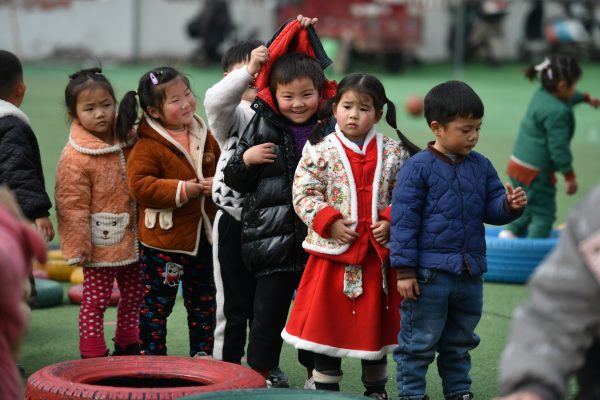In China, preschool education is split into early childhood education for 0 to 3 year-olds and kindergarten for 4 to 6 year-olds. At the end of 2021, the total kindergarten enrolment rate reached 88.1 per cent of the eligible population. Among enrolments, 87.8 per cent were able to register in government subsidised kindergartens. In contrast, early childhood education — including nursery services — is largely private. People rely on domestic family care and private nurseries.
Since the 1980s, people have not had sufficient access to public nurseries and kindergartens. Childcare for 0 to 3 year-olds is a family responsibility, the burden of care falling to grandparents and domestic carers. Some private educators started advocating for early childhood education, especially since 1998, targeting anxious middle-class parents who were worried about their children ‘losing at the starting line’. The number of publicly funded kindergartens declined continuously throughout the 1990s and the 2000s. In Beijing, the number of public kindergartens more than halved between 1996 and 2009. Some private kindergartens emerged, but the number was not sufficient to meet market demand.
The government’s renewed interest for supporting preschool education in the early 2000s was rooted in labour market concerns. One of the key issues was the middle-income trap, caused by an unskilled and poorly-educated labour force. In 2011, the national government started to provide preschool facilities in rural areas as part of the previous national agenda to eliminate absolute poverty. Government funding was insufficient and charity funds played an important role in sustaining the operation.
Women’s labour force participation and willingness to have children have been constrained by insufficient affordable childcare. Female labour force participation dropped from as high as 73 per cent in 1990 to below 60 per cent in 2020. In 2016, nearly one-third of full-time mothers had quit their jobs because of poor access to childcare and three-quarters of full-time mothers would look for jobs if they could get affordable childcare.
A linked consideration to government support is China’s low fertility rate. In 2016, the government announced the abolishment of the one-child policy, but the baby boom it hoped for did not occur. In the same year, 60.7 per cent of parents did not plan to have a second child because they worried about not having access to childcare.
Preschool education has changed rapidly since 2011 and it can now be either full-time or part-time. Both early childhood education and kindergarten can be full-time. Part-time education mainly includes parent-child activities and preschool learning for children aged 4 to 6. Activities can take place at children’s homes and in organised parent-child trips for children from 0 to 6 years old. For children 0–3 years old, activities can also take place in early education centres.
Broadly speaking, preschool education includes training in cognitive ability, language and hobbies. About half of the courses teach English, music and art. Education for children aged 0 to 3 focusses on physical functions and sensory training. Education for children aged 4 to 6 focusses more on overall competence and skills training, including English and art.
Monitoring teaching quality without putting too much pressure on children and their parents is a serious concern. The government is wary of educators’ tendency to turn preschool education into de facto school education and has banned preschools from preparing children for primary school entrance. Such preschools were criticised for suffocating children’s creativity and interest in studying.
But the ban does not coordinate with control measures, with many preschool education institutions requiring children to sit exams. They do so to monitor the effectiveness of their teaching, providing important evidence for the success of their brands. Preschool teachers put pressure on parents and children to prove their own teaching success. There is no clear path to escaping this vicious cycle.
Dividing the market between public and private providers is another issue that the government faces. As the state becomes more interested in providing public and subsidised kindergartens, private providers are being crowded out of the market. The market share for subsidised kindergartens increased by more than 25 per cent from 2011–2021. The private sector has gradually shifted to focussing on parenting skills and peripheral products and courses.
The ten years from 2011–2021 have been labelled a ‘Great Leap Forward’ in preschool education. This hints toward a problematic future when the state emphasises speedy construction of facilities and one-size-fits-all services. Quality improvement has fallen far behind quantitative expansion.
Bingqin Li is Professor and Director of the Chinese Social Policy Stream at the Social Policy Research Centre, University of New South Wales (UNSW), Sydney and Research Affiliate at the China Studies Centre, Sydney University.

